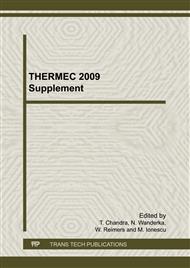p.527
p.533
p.539
p.545
p.551
p.556
p.562
p.568
p.574
Synchrotron µCT Investigation of the Collapsing Pore-Network of Gelatin Scaffolds under Compression
Abstract:
Biomaterials based tissue engineering requires optimization of several parameters. The most important parameters can be attributed to biocompatibility, degradational behaviour, mechanical stability and structural design. In previous studies we have established a porous gelatine based scaffold material, with parallel oriented pore channels. Although, tomographic data has been derived on dried scaffold samples, it remains unclear how the pore channel network interacts under load in a wet environment. We developed an experimental setup to compress biomaterials in a wet environment during exposure to synchrotron generated X-rays using a micrometer screw with a force sensor. Achieving good X-ray absorption contrast in polymeric biomaterials immersed in water is rather difficult, as water absorption prevents detailed imaging. Phase contrast imaging on the other hand allows for improved imaging results due to the attenuation of phase boundaries in the imaged data, neglecting effects of X-ray absorption in the watery phase nearly completely. Best results were obtained for X-ray energies of 30 keV with a scintillator to sample distance of 1090 mm with the established experimental setup. Due to over attenuation of phase boundaries at higher beam energies, this energy was finally chosen. As a result, we could evaluate the collapsing pore network upon loading with the possibility to enhance the structural design for future studies.
Info:
Periodical:
Pages:
551-555
Citation:
Online since:
January 2010
Keywords:
Price:
Сopyright:
© 2010 Trans Tech Publications Ltd. All Rights Reserved
Share:
Citation:


